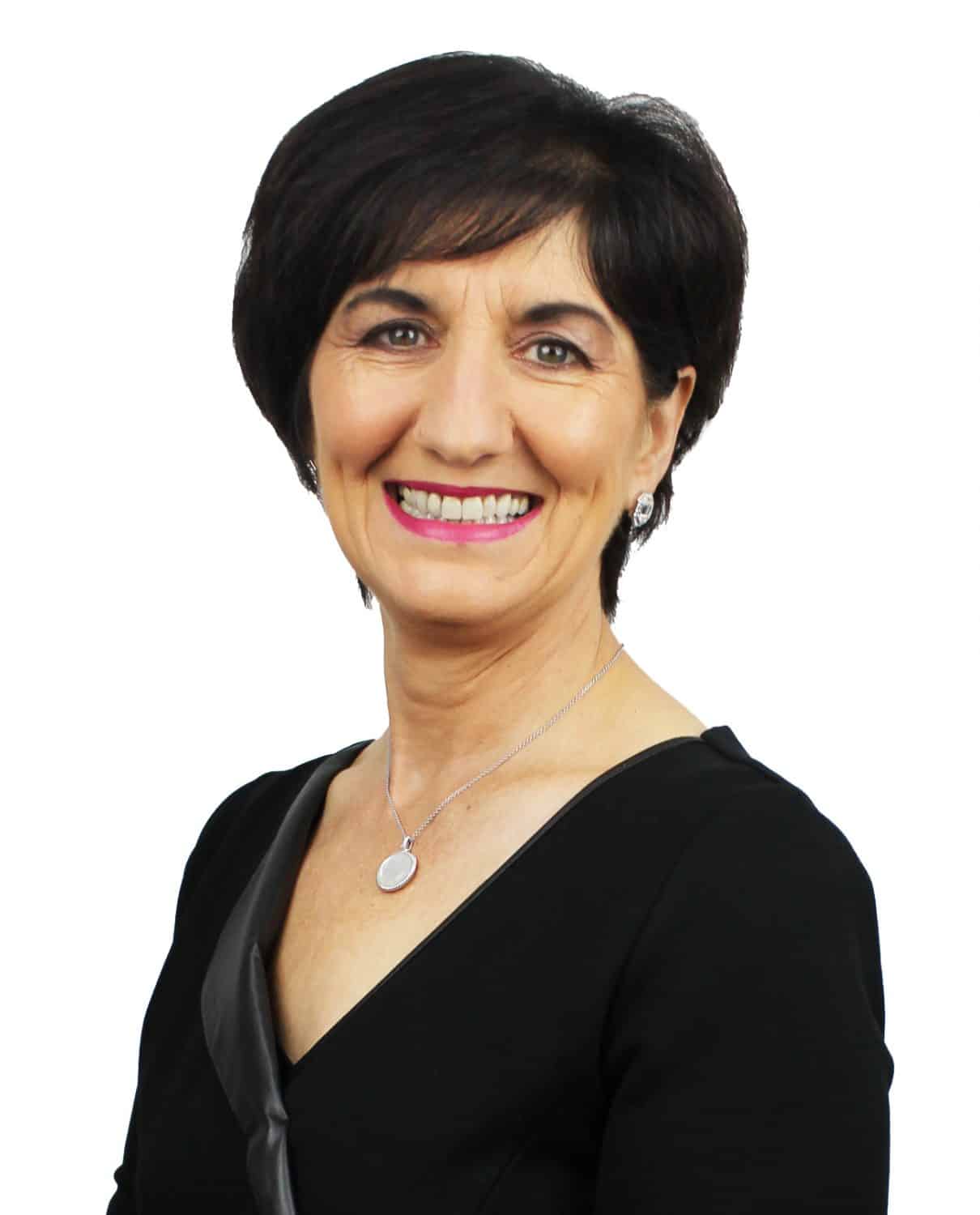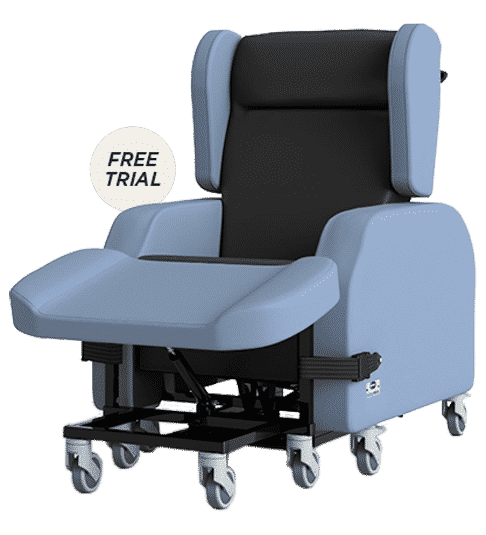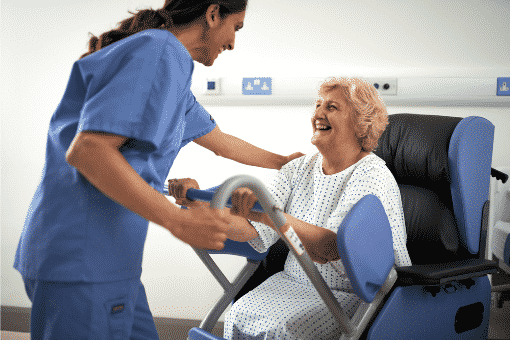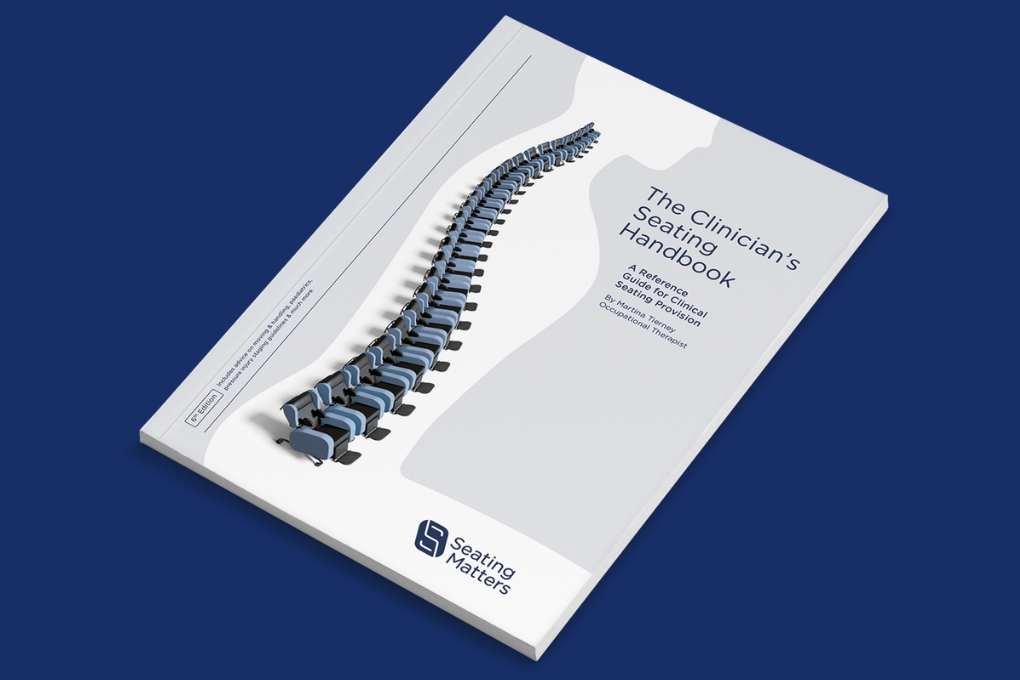Falls Prevention Chairs – How to Improve Patient Safety
Falls are a common occurrence in care facilities and hospitals and cause unnecessary suffering and pain. Fortunately there are methods to reduce falls risk – this article shares evidence based tips to support you*.
Falls from Chairs & Wheelchairs
Accidental falls from wheelchairs and chairs can place a huge strain on the patient, their family and on healthcare budgets in dealing with and treating these preventable injuries.
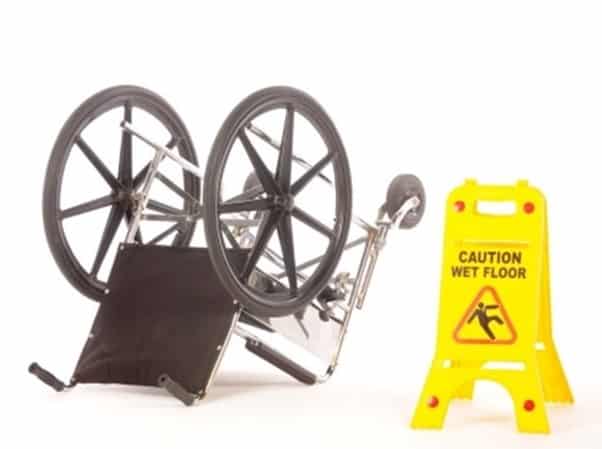
High Risk Categories
Falls and fall related injuries most commonly concern elderly members of the population but also patients suffering from low mobility due to different types of muscular and neurological diseases which impair their balance, sense of space and strength. Falls can also happen as a result of medication which patients might need which can sometimes result in feeling off balance and dizzy.
Those patients who may be unsteady on their feet, have low strength, or require extra assistance during sit to stand transfers are more at risk. Patients suffering from conditions such as Alzheimer’s Disease or Huntington’s Disease, with poor memory and cognitive impairment might impulsively try to stand up when seated and therefore are a high-risk category. The correct seating solution can keep these patients safer, more secure and less at risk, and will reduce falls risk.
Impact of Falls & Sliding from Chairs
When a patient has an unnecessary fall from their chair there are a large number of consequences that can result from this physically, mentally and economically.
1. Injury/Hurt – i.e. bruising , broken bones, open wounds.
2. Pressure ulcers – Repeated sliding out of a chair can cause shear which can contribute to an incidence of pressure ulcers.
3. Delayed rehab – Injuries from falls can affect rehabilitation of the patient –slowing down progress and increasing time spent in hospital and usually spent on bed rest.
4. Confidence/Dignity – When a patient suffers a fall, this can really damage their confidence in themselves and they will be less likely to move around as much, and therefore may become even more immobile and dependent on others for assistance and help. This affects their pride and dignity and results in them being less independent.
5. Manual handling risks – The need for constant re-positioning due to a patient sliding down their chair will mean an increase in staff time and an increase risk of injury due to excess manual handling requirements.
6. Expenses incurred – Hospitals/care homes have additional costs to fulfil, performing operations, purchasing new equipment not to mention increased staff time to aid manual re-positioning and treating injuries.
Causes of Falls & Sliding from Chairs
A common reason why patients end up sliding out of, or falling out of chairs is down to a lack of or an inadequate seating assessment. This results in the patient being put into a chair which typically doesn’t accommodate the four following factors:
- Loading the body.
- Accommodating hamstrings.
- Accommodating hip flexion.
- Loading of the feet on an appropriate footplate.2
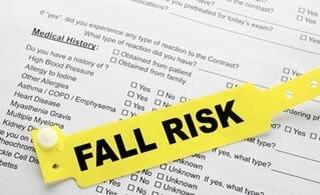
How to Reduce Falls & Sliding from Chairs
A proper seating assessment with prescription of a chair that is tailored to a patients height, leg length and clinical needs whilst also supporting posture and function, can dramatically reduce risk of falls and sliding. The following functions are key considerations:
1. Back angle recline:This function enables the back angle of the chair to be opened out to accommodate a fixed hip angle and prevents the patient being pulled forward in their seat.
2. Negative angle leg rest:This function accommodates those with tight hamstrings and enables them to be fully loaded into the chair and fully supported with their feet able to sit firmly behind the knee.
3. Adjustable footplate: This is necessary in order to load the feet as 19% of a person’s body weight goes through the feet when seated.3
4. Adjustable seat angle recline: Enables lowering the pelvis into the chair and creates a stable base of support for the person when seated.
5. The support from additional adaptations:
– Lateral supports : Helps keep the posture in mid line position, reducing falling to one side and needing re-positioning.
– Seatbelts: Can be useful to a certain extent but we recommend that they are only used during transfers and not constantly in use with patients.
6. Seat depth: The ability to adjust seat depth in a chair is a great function for a multi-user environment allowing one chair to suit many different body shapes. For patients with long legs, the ability to adjust the seat depth is essential to properly load the femurs into the chair.
7. Anterior leg rest function/Riser Function: Can help an individual slowly come to a standing position whilst being fully supported.
Conclusion
A thorough seating assessment and an investment in the correct, supportive equipment, can drastically improve the quality of life for patients at risk of falls and sliding from chairs. Not only that, but the additional benefits to the caregiver and the cost savings from the reduced need for additional treatment and time saved re-positioning cannot be underestimated. Perhaps the most important takeaway, is the reassurance to family members and caregivers that their patient or loved one is safe and secure from risk of injuries due to preventable falls.
References:
- Hospital News, Dec. 29, 2015, Don’t Hurt Me Heal Me. Be Nice to Me. https://issuu.com/hospitalnews/docs/flip_010216_hospital_news_edit_full/4
- Tierney, M., 2015, The Clinician’s Seating Handbook, 5th Ed., Northern Ireland: Seating Matters.
- Staas, W.E., Cioschi, H.M., 1991. Pressure sores: a multifaceted approach to prevention and treatment. Western Journal of Medicine, 154: 539-544.
*Note – the purpose of this blog is to give an overview of the product with some tips to consider on its use. This is not intended to be a substitute for professional or medical advice, diagnosis, prescription or treatment and does not constitute medical or other professional advice. For advice with your personal health or that of someone in your care, consult your doctor or appropriate medical professional.
As used by








Fallout Prevention Chairs
An unexpected fall is something that any person is shocked by. Consider, however, the feeling for a person who is aware that they are going to fall but can do nothing about it. Patients that are in elderly care or those with special needs often possess little functionality and are, therefore, unable to prevent a fall from happening on certain occasions.
A fall prevention chair is an ideal solution but few chairs actually are designed to limit or indeed stop such events from occurring. Fortunately, caregivers and care facilities throughout Australia can access the very best chairs that prevent falls.
At Seating Matters, we intend to transform the world of healthcare seating. As a registered NDIS provider and backed by clinical evidence with regards to their effectiveness in preventing pressure injuries, our chairs set the benchmark for comfortable, functional seating.
Regardless of whether you are looking for a chair for someone with complex disabilities, an elderly member of the community or a person who could use smart solutions that will enable them to maintain their independence, then you have come to the right place.
The True Cost of a Fall From a Chair
While a patient might fall onto a soft surface and incur little harm, it is worth considering the mental impact that such an event can have. Their self-confidence and fear of the world around them may be heightened as a result and so, while seated, they might be afraid of the consequences of falling asleep or sliding forward.
A fallout chair is primarily required to prevent the possibility of injury or hurt being incurred by a patient. Any child that has special needs could find their world much more difficult to navigate and will undoubtedly be much more stressed as a result of a bone-breaking, or open wounds. For an elderly person, even a bruise can take a long time to heal. All of this can be prevented by securing appropriate seating.
Consider the effect that a fall has on someone who is on the road to recovery. Imagine if they had made significant progress, found their confidence and felt positive about the future, only to them fall from their chair and learn that everything they achieved has been undone and must be worked toward once again, except after a potentially lengthy recovery period. It’s a huge setback for both the patient, their family and caregivers.
Finally, care facilities and hospitals can expect to incur greater expense in the wake of a patient falling. Operations may be required, new equipment will inevitably have to be invested in and then staff might have to learn new techniques and training methods, all of which eat into schedules as well as budgets.
We Provide Effective Fall Prevention Chair Solutions
At Seating Matters, our chairs are completely adjustable to suit a wide range of people. Through intensive seating research and an innovative approach to design and manufacture, we have achieved a great deal for those with complicated mobility and functionality requirements. We identified the key principles of correct positioning and the influence that it can have on health and we tailored our revolutionary chairs to meet and exceed these needs.
We are passionate about providing fall prevention chair solutions that are effective and deliver a sense of dignity and safety to patients. We also recognise the role that we play in helping caregivers deliver more effective treatment and support. A free seating assessment is a great way to determine just how worthwhile our chairs are and you can book yours by getting in touch today.
Seating Matters provides clinical healthcare seating chairs for Disabled & Elderly people in Australia. We sell bariatric chairs, pressure relief chairs, cerebral palsy chairs, occupational therapy chairs, parkinsons disease chairs, tub aged care chairs, huntington’s disease chairs, multiple sclerosis chairs, brain injury chairs, chairs for demantia patients & other seating range in Australia. Browse our website for more information or contact us for more details.
Read Less